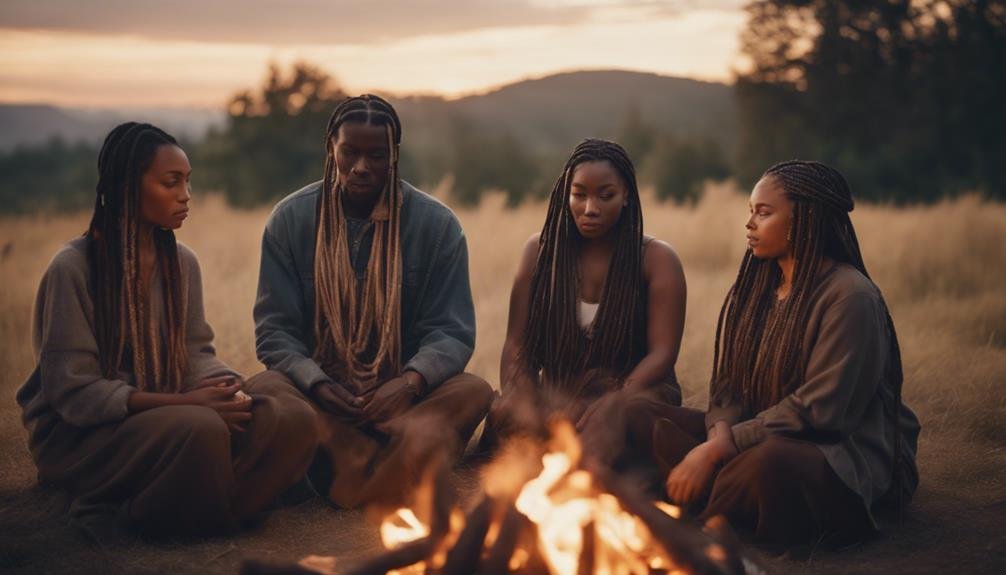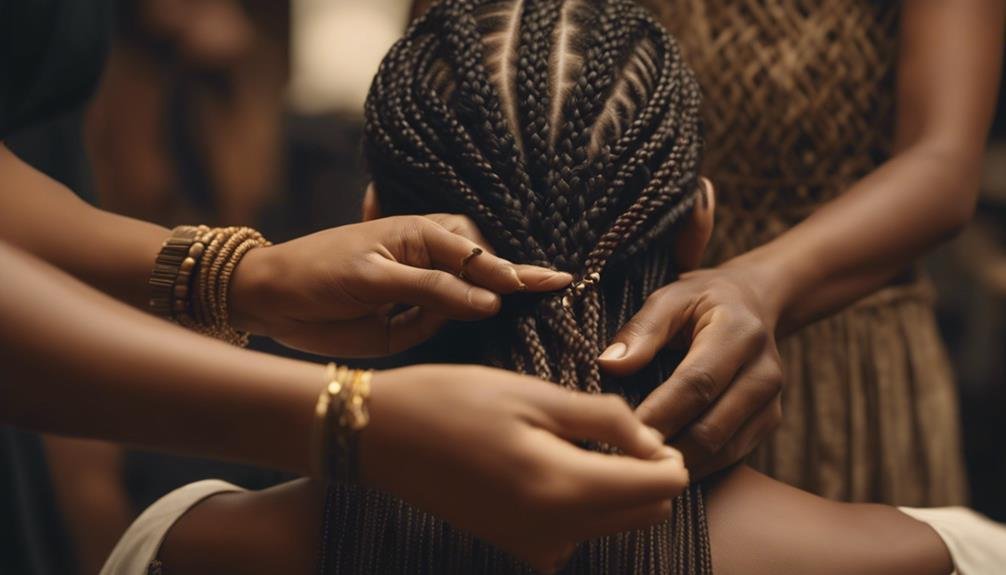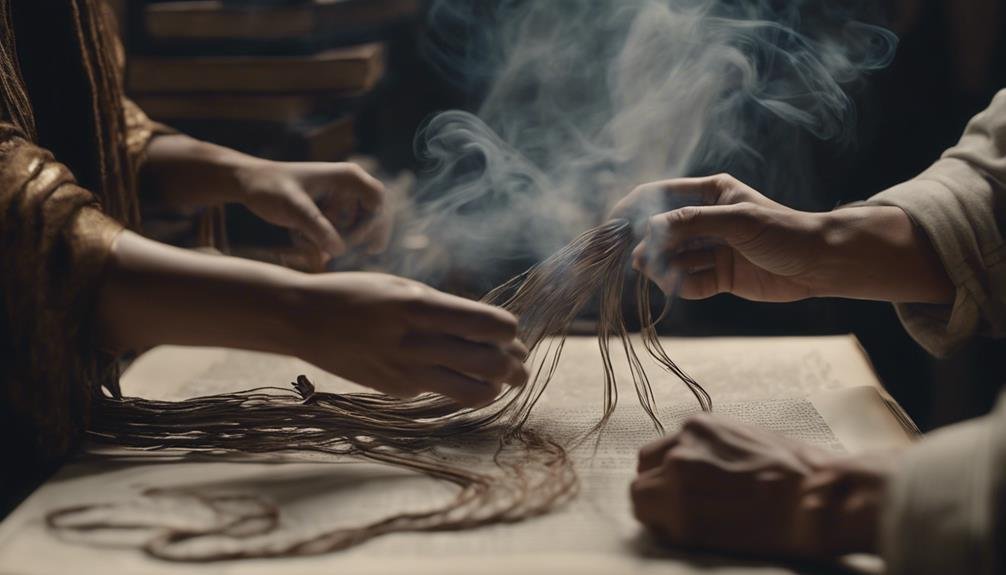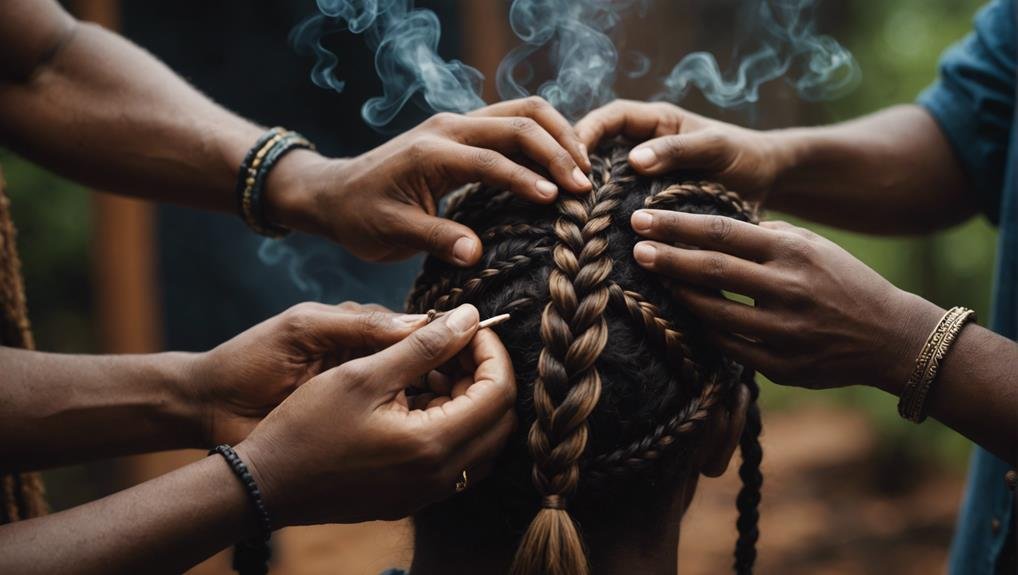You’ve likely seen traditional braids, but have you considered the deeper implications of reviving these styles using smoke in cultural braiding ceremonies? This practice, rooted in purification and spiritual connection, preserves heritage and fosters community healing. As you explore the significance of smoke in these rituals, you’ll find that it’s more than just a stylistic choice—it’s a powerful symbol of identity and resilience. How does this intertwining of the physical and spiritual enhance the social fabric of Indigenous communities? The answers might reshape your understanding of cultural preservation.
Key Takeaways
- Smoke in rituals enhances the spiritual significance of braiding ceremonies, fostering deeper community connections.
- Burning sacred herbs during braiding rituals purifies participants, promoting healing and emotional well-being.
- The use of smoke in braiding ceremonies bridges the physical and spiritual realms, strengthening cultural heritage.
- Incorporating smoke in traditional braiding reinforces identity and ancestral links, crucial for cultural revitalization.
- Smoke’s role in braiding rituals supports intergenerational healing and the preservation of indigenous traditions.
Cultural Significance of Braids
Braids aren’t just a style; they’re a profound expression of identity and heritage in many Indigenous communities. When you see these intricate patterns, you’re witnessing a living narrative, a historical context that explores deep into the roots of Indigenous cultures. Each braid carries the weight of ancestral wisdom, symbolizing not only personal and spiritual strength but also the resilience and unity of a community.
Understanding the historical context of braiding in these communities helps you appreciate how these hairstyles are more than mere beauty or fashion statements. They’re a form of language, a method of storytelling that has traversed generations. Traditionally, the techniques and patterns used can signify everything from tribal affiliation to social status, each chosen deliberately to convey specific messages and values.
Moreover, the act of braiding itself fosters a sense of community and continuity. It’s a time-honored ritual where knowledge and stories are passed down, strengthening the bonds between generations. This communal practice isn’t just about maintaining hair; it’s about honoring and perpetuating a rich cultural heritage. Through braids, you’re connected to history, to the land, and to each other.
Smoke in Ritual and Ceremony
Just as braiding is a deeply rooted cultural practice, the use of smoke in rituals and ceremonies holds profound spiritual significance for American Indian communities. This ancient tradition involves the burning of sacred herbs like sage, sweetgrass, and cedar. The smoke from these herbs isn’t just smoke; it’s a bridge connecting you, the physical being, to the spiritual domains. It’s believed to carry your prayers directly to the Great Spirit, enveloping you in a sacred atmosphere of purity and spiritual renewal.
When you participate in these ceremonies, you’ll find that the smoke serves multiple sacred purposes:
- Purification: Cleansing people, sacred objects, and spaces from negative energies.
- Spiritual Connection: Facilitating a deeper connection with the spiritual world.
- Protection: Offering a shield against spiritual and physical harm.
- Harmony and Balance: Promoting peace within the environment and among participants.
Understanding smoke in ritual and ceremony enriches your appreciation of how deeply entwined natural elements are with spiritual practices. Each plume of smoke rises not just as a part of the ceremony, but as a crucial act of cultural preservation, linking past, present, and future in a continuous sacred circle.
Impact on Community Healing

Throughout American Indian communities, the resurgence of traditional braiding ceremonies plays a crucial role in healing both individuals and the collective spirit. As you participate or witness these ceremonies, you’re not just seeing strands of hair being intertwined; you’re watching the weaving of unity, strength, and resilience. This practice isn’t only about aesthetics; it’s a profound form of cultural therapy that addresses intergenerational wounds head-on.
By joining in these gatherings, you’re stepping into a space where stories, traditions, and experiences are shared openly. It’s here that emotional healing permeates through the air, as powerful as the smoke used in ritual and ceremony. You’ll see firsthand how these practices contribute to a revitalized community spirit and foster a deep sense of belonging.
| Aspect of Healing | Impact in Community |
|---|---|
| Cultural Revitalization | Strengthens bonds and pride |
| Emotional Healing | Provides space for sharing and support |
| Intergenerational Healing | Addresses and mends historical traumas |
Reclaiming Identity Through Tradition
For many American Indian men, reclaiming traditional braids is a direct path to rediscovering and affirming their cultural identity. By choosing to wear braids, you’re not just adopting a hairstyle; you’re embracing a symbol of strength and resilience that has deep roots in your heritage. It’s a powerful way to connect with your ancestors and carry forward the traditions that define your community.
Braiding isn’t just about appearance; it’s a ritual that ties you to generations past and empowers you to preserve these cultural practices. Each twist and turn of your hair isn’t merely a style—it’s a tribute to survival and endurance. Embracing this aspect of your culture can greatly enhance your pride and sense of belonging, making you feel more grounded and connected to your identity.
Here are a few reasons why embracing traditional braids is so impactful:
- Strengthens cultural connections: You’re wearing a piece of history that honors your ancestors.
- Preserves important traditions: Keeps the legacy of your culture alive for future generations.
- Symbolizes resilience and pride: Reflects the enduring spirit of your community.
- Promotes healing and empowerment: Helps reclaim what was lost and fortify your identity.
Role of Braids in Heritage

Braids serve not only as a personal expression but also as a profound link to your heritage, embodying centuries of cultural identity, family ties, and spiritual connections. Each plait and twist carries stories of your ancestors, becoming a medium through which the wisdom and artistry of past generations are conveyed. This intergenerational传代 tradition isn’t just about maintaining aesthetic continuity; it’s a dynamic practice that strengthens communal bonds and affirms your place within a lineage that has thrived through resilience and resistance.
In Native American cultures, the act of braiding is more than a routine grooming habit—it’s a sacred ritual. Specific patterns signify tribal affiliations and mark significant life stages, encapsulating the values of strength, unity, and pride. By wearing traditional braids, you wear the history of your people, visibly asserting indigenous identity and the unbroken chain of survival against numerous adversities.
Moreover, these braids aren’t static symbols; they evolve, incorporating contemporary elements while respecting the essence of tradition. This living heritage adapts, ensuring that the crucial connections to your roots remain relevant and resonant in today’s world. As you carry forward these braiding techniques, you’re not just preserving culture; you’re actively participating in its unfolding story.
Educational Initiatives and Support
Building on the rich traditions of braiding, educational initiatives now play a key role in preserving and passing down these cultural techniques. By engaging in these programs, you’re not just learning a skill, you’re becoming part of a movement that honors and revitalizes your cultural heritage. These programs aren’t just about braiding; they’re platforms for intergenerational knowledge transfer, where the wisdom of the elders enriches the youth, and new life is breathed into ancient practices.
Here’s what you’ll gain from participating in these educational initiatives:
- Cultural Revitalization: Rediscover and engage with traditional practices that are the backbone of your community’s identity.
- Empowerment: Gain a strong sense of pride and self-worth by mastering a skill that’s been passed down through generations.
- Community Connection: Meet and bond with others who share a passion for preserving your cultural legacy.
- Sustainability: Contribute to the cultural resilience and sustainability of your community by keeping traditional braiding alive and vibrant.
Support for these educational courses helps safeguard that the beauty and intricacy of traditional braids aren’t lost but are celebrated and continued by future generations. You’re not just learning to braid; you’re weaving the very fabric of your culture.
How Have Traditional Braids in the African Diaspora Made an Impact on Modern Braiding Techniques?
Traditional braids in the African diaspora have influenced modern braiding techniques significantly. These braids offer valuable insights on braids African diaspora, showcasing the rich cultural heritage and history behind this art form. Through intricate styling and unique patterns, they demonstrate the beauty and versatility of African hair, inspiring new trends and broadening the possibilities in hairstyling.
Policy Recommendations for Cultural Preservation

To effectively preserve the art of traditional braiding, policymakers must support legislation that protects these cultural practices. You should advocate for laws that safeguard and celebrate braiding techniques, guaranteeing they’re not only maintained but also appreciated as crucial cultural heritage. This involves funding initiatives specifically aimed at revitalizing these traditions within American Indian communities, where they hold significant cultural and historical importance.
It’s essential to foster partnerships between tribal governments, educational institutions, and community organizations. These collaborations can create robust support networks that ensure the sustainability of braiding traditions. By working together, these groups can share resources, knowledge, and platforms, amplifying the impact of their preservation efforts.
Additionally, it would be best if you pushed for the development of educational guidelines and resources that help both policymakers. The general public understands the critical role of cultural preservation. This education can shift perceptions and increase support for these initiatives.
Conclusion
By embracing the cultural practice of using smoke in braiding rituals, you’re not just preserving a tradition; you’re healing and unifying your community.
This act of reclaiming your heritage strengthens your collective identity and resilience. Let’s continue to educate and support these practices while advocating for policies that protect and promote our cultural legacies.
Your engagement and pride in these rituals pave the way for a richer, more connected future.

